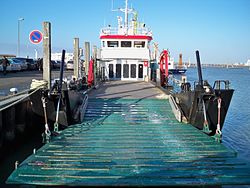Janssand
|
2014 in the port of Norddeich
|
||||||||||||||||
|
||||||||||||||||
|
||||||||||||||||
|
||||||||||||||||
|
||||||||||||||||
|
||||||||||||||||
The Janssand is a multi-purpose ship for the pollution accident control of the Lower Saxony State Office for Water Management, Coastal and Nature Conservation (NLWKN), North-Norderney office. It is available to the emergency command to fight oil and pollutant accidents .
history
Today's Janssand was built in 1954 as a landing craft . After this was initially used for military purposes, it has been available to the Lower Saxony State Office for Water Management, Coastal Protection and Nature Conservation since the 1970s.
In 1988 the ship was lengthened by around four meters at the Lühring shipyard in Brake . During the renovation, the engine system was also renewed and an oil brigade was installed, which turned the vehicle, which had been used exclusively for transport tasks, into a multi-purpose ship. During a further renovation in 2003, it was equipped with a modern brush system for fighting oil spills.
In 2018 the ship was decommissioned and offered for sale via Vebeg .
Technical specifications
The vessel is powered by two diesel engines of the manufacturer Klöckner-Humboldt-Deutz (type: SA6M816) each with 165 kW power driven, acting through reduction gearing on two fixed propeller. It can reach a speed of up to 9 knots . In the bow of the ship there is a cone jet as a cross- flow control system .
The ship is equipped with a hydraulic diesel engine from the manufacturer MWM (type: D 234-06) with 140 kW power and a generator diesel engine also from the manufacturer MWM (type: 228-4) with 31 kW power.
The work and cargo deck is 95 square meters. This is accessible via a five meter long and 4.2 meter wide, hydraulically operated bow ramp . In addition, the ship is equipped with two board cranes, each of which can lift around 1 t.
To combat oil spills, the ship is equipped with a brush system for oil absorption. In addition, it has explosion protection equipment and a gas warning system as well as other special equipment for combating oil and pollutant accidents, which is always on board.
The ship has an extinguishing agent tank in which 1,000 l of foam extinguishing agent for fire fighting can be carried.
On board are, among other things, two chambers, one chamber with two berths and one chamber with four berths, which is divided into two areas with two berths each with a room divider, and a mess room with pantry.
commitment
In everyday life, the Janssand mainly performs transport tasks in island and coastal protection. The ship, which is only 1.30 meters deep when unloaded, is particularly suitable for shallow waters. Since it can fall dry , the bow ramp can also be used independently of port facilities.
To combat oil, the boom oil barriers installed on board can be extended with a length of 6 meters on each side, so that with the width of the ship there is a pick-up width of around 19 meters. Oil on the water is fed to a brush system via the oil barriers. The system, equipped with two rotating brush belts on each side of the ship, picks up the oil from the surface of the water. It is pumped into the cargo tanks available for this purpose or into the deck tank that can be installed on deck. In this way, up to 40 cubic meters of oil per hour and side of the ship can be siphoned off.
Web links
- Multi-purpose ship "Janssand" ( Memento from September 6, 2017 in the Internet Archive ), leaflet from the Lower Saxony State Office for Water Management, Coastal and Nature Conservation (PDF, 1.1 MB)
- Multi-purpose ship "Janssand" ( Memento from June 28, 2018 in the Internet Archive ), Vebeg tender (PDF, 1.6 MB)
